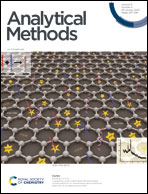The construction of a CND/Cu2+ fluorescence sensing system for the ultrasensitive detection of glyphosate†
Abstract
In this work, a coumarin derivative (CND) was synthesized by a one-step condensation reaction and exhibited selective fluorescence quenching by Cu2+. Glyphosate with amine and carboxylate groups provided strong chelation for Cu2+ from the CND/Cu2+ system, leading to fluorescence recovery. In this strategy, a CND/Cu2+ fluorescence sensing system was constructed to achieve the quantitative analysis of glyphosate. Under the optimized experimental conditions, a good linear relationship between CND and Cu2+ of glyphosate concentration in the range from 0.02 μg mL−1 to 1.50 μg mL−1 was obtained and the correlation coefficient was 0.99. The detection limit was calculated to be 18.30 ng mL−1 (S/N = 3) and presented relative advantages compared with other methods. The interference study exhibited excellent selectivity towards glyphosate. In addition, satisfactory recoveries ranging from 91.31% to 105.28% were achieved for the real samples. These results indicate that the CND/Cu2+ fluorescence sensing system has practical application prospects.



 Please wait while we load your content...
Please wait while we load your content...